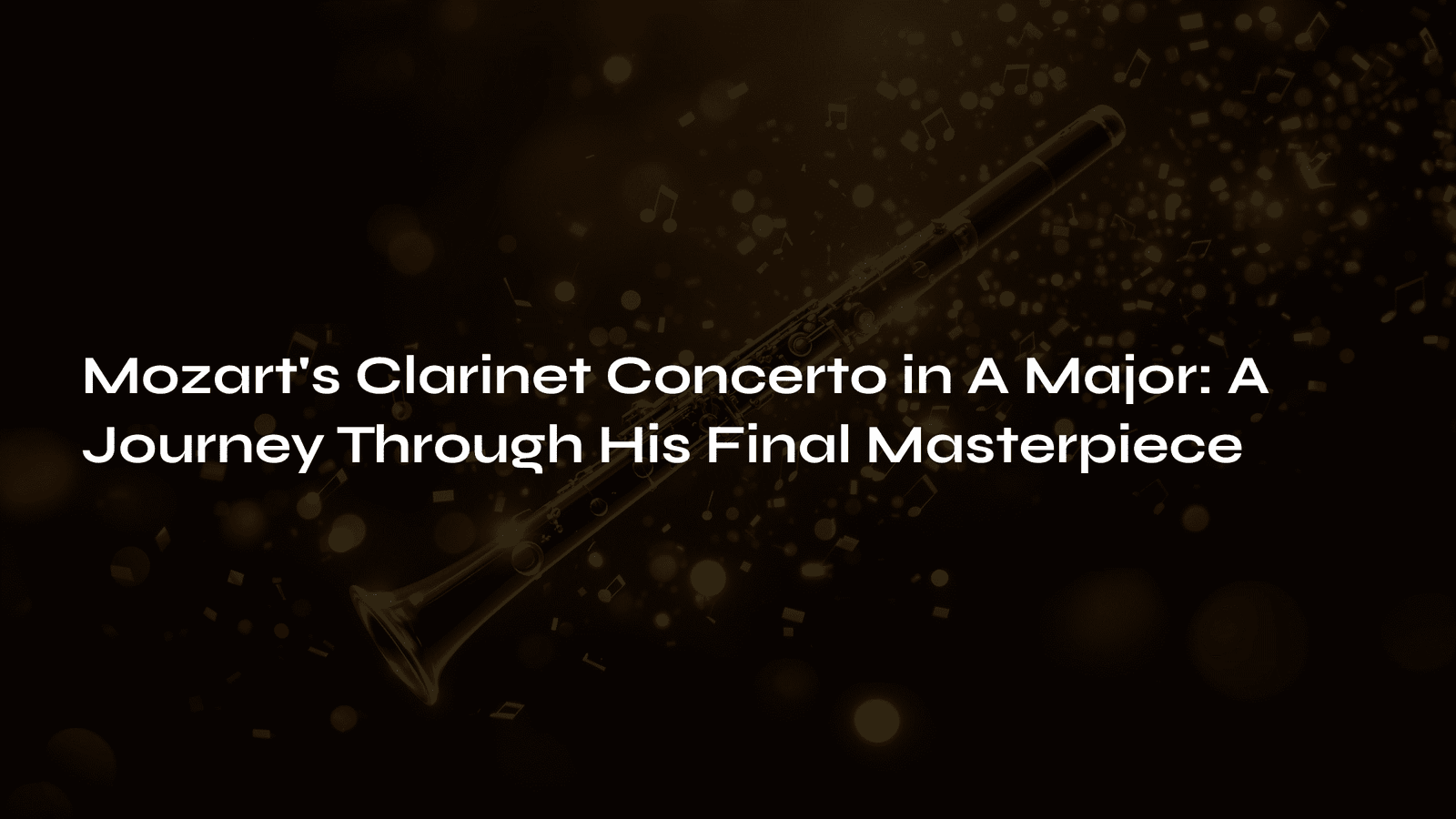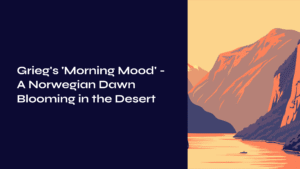Table of Contents

When Music Becomes Memory
There’s something deeply moving about encountering a piece of music that seems to speak directly to your soul. Mozart’s Clarinet Concerto in A Major, K. 622, has this rare quality—it doesn’t just play in the background of your life; it becomes part of your emotional landscape. The way the clarinet’s voice emerges from the orchestra, tender yet confident, creates an intimacy that feels almost conversational. This isn’t just another classical concerto; it’s Mozart’s final instrumental testament, completed just weeks before his death in 1791, carrying with it the weight of farewell and the lightness of transcendent beauty.

The Story Behind the Swan Song
Understanding this concerto means understanding both its creator’s final chapter and the remarkable friendship that inspired it. Mozart wrote this piece for Anton Stadler, a virtuoso clarinetist who had become not just a musical collaborator but a trusted friend. Stadler played a special instrument—the basset clarinet—which could reach lower notes than ordinary clarinets, and Mozart composed specifically for this extended range.
The timing couldn’t be more poignant. October 1791 found Mozart in his final creative surge, and this concerto emerged as his last completed instrumental work. While his body was failing, his musical imagination remained as vivid as ever. The concerto represents what Wolfgang Hildesheimer called Mozart’s “last great completed work of any kind,” making every note feel both precious and eternal.
Mozart’s own words about Stadler’s playing reveal the deep musical understanding behind this composition: “Never would I have thought that a clarinet could be capable of imitating the human voice as deceptively as it is imitated by you.” This human quality—the clarinet’s ability to sing like a voice—becomes the concerto’s defining characteristic.

A Musical Architecture of Three Movements
First Movement: Allegro – The Graceful Introduction
The opening movement establishes the concerto’s character with a balance of classical elegance and innovative writing. Mozart creates a dialogue between soloist and orchestra that feels more like a conversation among friends than a display of virtuosity. The clarinet enters not with flashy brilliance but with melodic grace, immediately establishing the work’s intimate tone.
The orchestration here reveals Mozart’s careful consideration for the clarinet’s voice. By excluding oboes, trumpets, and timpani—the orchestra’s most piercing voices—he ensures that the clarinet’s mellow tones can float above and weave through the ensemble without being overwhelmed.
Second Movement: Adagio – The Heart of the Matter
If the first movement introduces us to the clarinet’s world, the Adagio movement is where we fall completely under its spell. Set in D major and structured in a gentle ternary form, this movement embodies what many consider “the most enchanting movement Mozart has written.”
Here, Mozart achieves something remarkable: music that seems to pour forth unimpeded, where each phrase dovetails seamlessly into the next. The clarinet’s melody spans over three octaves, incorporating delicate ornaments that feel not like technical display but like natural breathing. The harmony, while mostly diatonic, gains sophistication through subtle chromaticism that adds gentle expressiveness without disturbing the movement’s peaceful character.
The emotional character of this movement has been described as embodying “love and melancholy at the same time”—perhaps reflecting Mozart’s own emotional state as he faced his mortality while creating this beautiful music. Unlike more dramatically conceived slow movements, this Adagio achieves its impact through tender beauty rather than passionate intensity.
Third Movement: Rondo – The Joyful Farewell
The final movement returns to a brighter mood with a rondo structure that feels both playful and sophisticated. Mozart provides the clarinet with opportunities for technical display while maintaining the work’s essential character of musical conversation rather than mere virtuosic exhibition.

A Personal Encounter with Immortality
Listening to this concerto today, you can’t help but be struck by its dual nature. On one level, it’s music of extraordinary technical sophistication—Mozart’s mature compositional craft is evident in every measure. But on another level, it speaks with such directness and warmth that it feels like receiving a personal message across the centuries.
The Adagio movement, in particular, has this remarkable ability to create what feels like suspended time. As one devoted listener noted, “I often play this movement on repeat as I cannot get enough of it.” There’s something about the clarinet’s voice in this movement that seems to bypass analytical listening entirely and speak directly to the emotions.
The work’s capacity to move listeners across cultural and temporal boundaries suggests something profound about Mozart’s achievement here. He created music that combines intellectual satisfaction with emotional immediacy—no small feat in any era.

How to Listen Deeper
To fully appreciate this concerto, try listening with attention to the relationship between soloist and orchestra. Rather than thinking of the clarinet as a star with accompaniment, notice how Mozart creates genuine musical conversations. Sometimes the orchestra introduces an idea that the clarinet develops; other times, the clarinet sings a melody that the orchestra then comments upon.
Pay special attention to the orchestration choices. The absence of oboes and trumpets isn’t just practical—it’s artistic. Mozart creates a sound world where the clarinet can be both intimate and grand, never having to fight for space.
If possible, seek out recordings that use the basset clarinet, the instrument Mozart actually wrote for. While performances on modern clarinets are beautiful, hearing the work on Mozart’s intended instrument reveals additional depths, particularly in the lower register passages.
Listen to the Adagio movement with particular attention to how Mozart handles the flow between phrases. Notice how rarely the music actually stops—even when one melodic line ends, another has usually already begun, creating that sense of unimpeded musical flow that Charles Rosen identified as characteristic of Mozart’s mature style.

The Eternal Echo
Mozart’s Clarinet Concerto stands as more than just a beautiful piece of music—it’s a testament to the power of friendship, the resilience of creativity in the face of mortality, and the ability of human expression to transcend its historical moment. Written for a friend, completed in the shadow of death, it nevertheless radiates warmth, beauty, and an almost miraculous sense of peace.
The work continues to find new audiences and new meanings. Its presence in film soundtracks, its arrangement for various instruments, and its status as a cornerstone of the clarinet repertoire all testify to its enduring power. But perhaps most remarkably, it retains its ability to surprise and move listeners, even after more than two centuries.
In our fast-paced world, this concerto offers something increasingly rare: music that rewards patient listening, that reveals new beauties with each encounter, and that speaks to something timeless in human experience. It reminds us that the greatest art doesn’t just entertain—it transforms, offering us glimpses of beauty that make life itself feel more meaningful and more precious.

If You Loved This, Listen to This Next
If you were moved by Mozart’s ability to weave profound emotion into elegant musical structures in this clarinet concerto, you might find yourself equally captivated by Dvořák’s Humoresque No. 7: When Melancholy Meets Joy in Six Flats – where similar emotional complexity and melodic genius create an intimate musical experience that dances between joy and wistfulness.
Both works reveal how master composers can distill complex human emotions into melodies that speak directly to the heart, creating music that feels both deeply personal and universally resonant.



